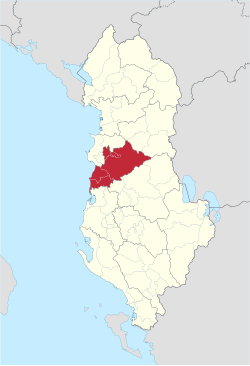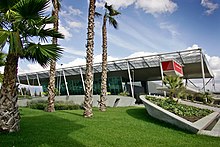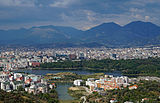Tirana County
Tirana County
Qarku i Tiranës (Albanian) | |
|---|---|
 | |
 Map of Albania with Tirana County highlighted | |
| Coordinates: 41°15′N 19°45′E / 41.250°N 19.750°E | |
| Country | |
| Seat | Tirana |
| Subdivisions | 5 municipalities: |
| Government | |
| • 1st of 12 | |
| NUTS Code | AL022 |
| Website | qarkutirane |
Tirana County (
The capital of the county is Tirana, which is also the largest city by area and population in Albania. A gamma-world-city, it is the most influential economic and political center of the country.[2]
History
Pre-Albanian Independence
The region, which presently corresponds to the territory of the county of Tirana, has been continuously inhabited since the
The oldest discovery in downtown Tirana was a Roman house, later transformed into an aisleless church with a mosaic-floor, dating to the 3rd century A.D., with other remains found near a medieval temple at Shengjin Fountain in the eastern suburbs. A castle possibly called Tirkan or Theranda, whose remnants are found along Murat Toptani Street, was built by Emperor Justinian in 520 A.D. and restored by Ahmed Pasha Toptani in the 18th century.[3] The area had no special importance in Illyrian and classical times. In 1510, Marin Barleti, an Albanian Catholic priest and scholar, in the biography of the Albanian national hero Skanderbeg referred to this area as a small village.[4]
Geography
Defined in an area of 1,652 km2 (638 sq mi), Tirana County is located in the
Tirana County from the shorelines of the
Climate
The Adriatic Sea and Skanderbeg Mountains have a particular influence to the climate of Tirana County, though it has a Mediterranean climate with four distinct seasons. Summers are generally warm and dry, while winters are relatively cool and mild, and rarely very cold.[7] The highest temperature of 41.5 °C (106.7 °F) was recorded in the city of Tirana, whereas the lowest temperature of −34.7 °C (−30.5 °F) was recorded in the village of Bixë.[7]
Protected areas
The
Demography
| Population growth of Tirana County in selected periods | |||||||
|---|---|---|---|---|---|---|---|
| Year | 2001 | 2002 | 2006 | 2010 | 2014 | 2018 | 2020 |
| Pop. | 596,704 | 617,550 | 683,927 | 747,169 | 816,222 | 883,996 | 906,166 |
| ±% p.a. | — | +3.49% | +2.59% | +2.24% | +2.23% | +2.01% | +1.25% |
| Source: [9] | |||||||
Tirana County is the
Tirana County has experienced a generally high rate of population increase since the late twentieth century in part due to the fall of communism.[6] Internal migration has been a significant factor in its population growth, especially from Berat, Dibër and Kukës.[6] Nonetheless, the most densely populated areas are positioned in the flat western half, and the region around the relatively small corridor of the city of Tirana, thus the lowest densities are located in the mountainous eastern half.
As of the
Settlements
Tirana County is overwhelmingly
| The county's largest urban areas by population as of 2011[update].[12] | ||||||||||||||
|---|---|---|---|---|---|---|---|---|---|---|---|---|---|---|
|
|
Rank | Administrative unit | Municipality | Population | Rank | Administrative unit | Municipality | Population |
| |||||
| 1 | Tirana | Tirana | 418,495 | 6 | Kavajë | Kavajë | 20,192 | |||||||
| 2 | Kamëz | Kamëz | 66,841 | 7 | Dajt | Tirana | 20,139 | |||||||
| 3 | Kashar | Tirana | 43,353 | 8 | Vorë | Vorë | 10,901 | |||||||
| 4 | Paskuqan | Kamëz | 37,349 | 9 | Bërxullë | Vorë | 9,883 | |||||||
| 5 | Farkë | Tirana | 22,633 | 10 | Vaqarr | Tirana | 9,106 | |||||||
Economy
Transport

Development and maintenance of
Tirana County is served by
The county is connected by a well developed system of expressways and motorways. The main west–east corridor is Rruga Shtetërore 2 (SH2), which connects the country's capital Tirana with the country's second largest city Durrës in Durrës County. The north-south corridor is Rruga Shtetërore 3 (SH3), which is currently being transformed into the Autostrada 3 (A3), covering the distance between Tirana and the country's fourth largest city Elbasan in Elbasan County. Rruga Shtetërore 4 (SH4) passes through Kavajë in the west from north to south linking Durrës with Greece. However, after its completion, the Arbër Highway will connect the county with Dibër County and North Macedonia.
Tourism
The contribution of tourism to the economy of Tirana has significantly increased over the past years.
See also
References
- ^ a b "Population on 1st January by prefecture and sex" (PDF). INSTAT. 7 May 2021. p. 6.
- ^ "The World According to GaWC 2020". Globalization and World Cities Research Network (GaWC). Archived from the original on 6 October 2020. Retrieved 13 October 2020.
- ^ ISBN 978-3-205-98255-5.
- ^ To know more about the history of Tirana, please consult Tirana ne shekuj: Terona, Theranda, Tirkan, Tirannea, Tirana : monografi, disa artikuj e materiale arkivore kushtuar historisë së Tiranës by Skënder Jasa. (Victoria, 1997)
- ^ "A new Urban–Rural Classification of Albanian Population" (PDF). Instituti i Statistikës (INSTAT). May 2014. p. 15. Archived from the original (PDF) on 14 November 2019. Retrieved 28 September 2020.
- ^ a b c d e "Koncepti i Zhvillimit Rajonal per Qarkun e Tiranes" (PDF) (in Albanian). Tirana: Qarku Tiranë. November 2012. Retrieved 22 July 2020.
- ^ a b Noti, Elton; Totoni, Lorena (19 May 2012). "Qarku Tiranë–Guidë 2012" (PDF) (in Albanian). Qarku Tiranë. p. 6. Retrieved 22 July 2020.
- ^ "Databazë e Burimeve Turistike–Qarku Tiranë" (PDF) (in Albanian). Ministria e Turizmit dhe Mjedisit. Archived from the original (PDF) on 3 September 2018. Retrieved 22 July 2020.
- ^ "Popullsia në 1 Janar sipas qarqeve dhe gjinisë 2001 - 2020" (in Albanian). Instituti i Statistikës (INSTAT). Retrieved 22 July 2020.
- ^ "Censusi i popullsisë dhe banesave/ Population and Housing Census 2011" (PDF) (in Albanian). Instituti i Statistikës (INSTAT). p. 133. Archived from the original (PDF) on 24 July 2020. Retrieved 24 July 2020.
- ^ Dhuli, Elsa. "Vjetari Statistikor Rajonal, 2019" (PDF) (in Albanian). Instituti i Statistikës (INSTAT). p. 25. Archived from the original (PDF) on 20 July 2020. Retrieved 20 July 2020.
- ^ a b c d e f "Censusi i popullsisë dhe banesave/ Population and Housing Census–Tiranë (2011)" (PDF) (in Albanian). Instituti i Statistikës (INSTAT). pp. 39–40. Archived from the original (PDF) on 23 August 2017. Retrieved 20 July 2020.
- ^ "Law nr. 115/2014" (PDF) (in Albanian). p. 6375. Retrieved 25 February 2022.
- ^ "Statistikat e transportit" (PDF) (in Albanian). Instituti i Statistikës (INSTAT). 27 January 2019. p. 2. Retrieved 21 July 2020.
- ^ a b "Strategjia e Zhvillimit të Qendrueshëm të Bashkisë Tiranë 2018–2022" (PDF) (in Albanian). Bashkia Tiranë. pp. 71–75. Archived from the original (PDF) on 13 June 2020. Retrieved 28 September 2020.





